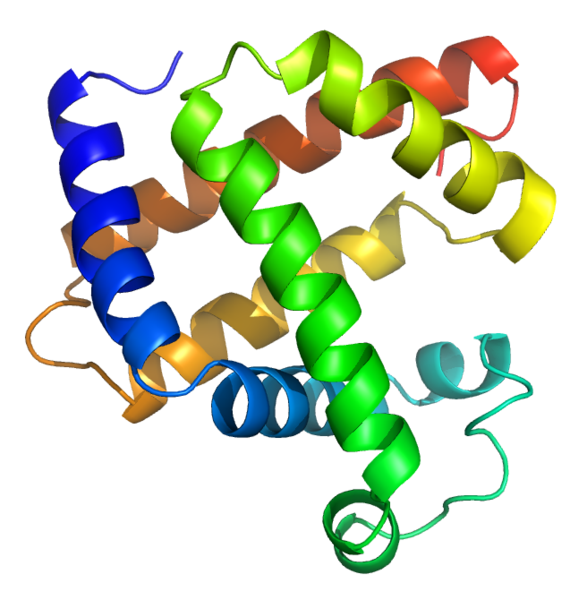Myoglobinuria: Difference between revisions
| Line 52: | Line 52: | ||
|-bgcolor="LightSteelBlue" | |-bgcolor="LightSteelBlue" | ||
| '''Genetic''' | | '''Genetic''' | ||
|bgcolor="Beige"| [[Calcium ATPase|Brody myopathy]], [[Carnitine palmitoyltransferase 1 deficiency]], [[Carnitine palmitoyltransferase 2 deficiency]], [[Familial paroxysmal rhabdomyolysis]], [[Glycogen disease type V]], [[Succinate dehydrogenase|Myopathy with deficiency of succinate dehydrogenase and aconitase]], [[Phosphoglycerate kinase|Phosphoglycerate kinase deficiency]], [[Phosphoglycerate mutase|Phosphogylcerate mutase 2 deficiency]], [[Very long-chain acyl-coenzyme A dehydrogenase deficiency]] | |bgcolor="Beige"| [[Calcium ATPase|Brody myopathy]], [[Carnitine palmitoyltransferase 1 deficiency]], [[Carnitine palmitoyltransferase 2 deficiency]], [[Familial paroxysmal rhabdomyolysis]], [[Glycogen storage disease type V]], [[Succinate dehydrogenase|Myopathy with deficiency of succinate dehydrogenase and aconitase]], [[Phosphoglycerate kinase|Phosphoglycerate kinase deficiency]], [[Phosphoglycerate mutase|Phosphogylcerate mutase 2 deficiency]], [[Very long-chain acyl-coenzyme A dehydrogenase deficiency]] | ||
|- | |- | ||
|-bgcolor="LightSteelBlue" | |-bgcolor="LightSteelBlue" | ||
Revision as of 15:55, 7 November 2016
| Myoglobinuria | |
 | |
|---|---|
| Model of helical domains in myoglobin. |
|
WikiDoc Resources for Myoglobinuria |
|
Articles |
|---|
|
Most recent articles on Myoglobinuria Most cited articles on Myoglobinuria |
|
Media |
|
Powerpoint slides on Myoglobinuria |
|
Evidence Based Medicine |
|
Clinical Trials |
|
Ongoing Trials on Myoglobinuria at Clinical Trials.gov Trial results on Myoglobinuria Clinical Trials on Myoglobinuria at Google
|
|
Guidelines / Policies / Govt |
|
US National Guidelines Clearinghouse on Myoglobinuria NICE Guidance on Myoglobinuria
|
|
Books |
|
News |
|
Commentary |
|
Definitions |
|
Patient Resources / Community |
|
Patient resources on Myoglobinuria Discussion groups on Myoglobinuria Patient Handouts on Myoglobinuria Directions to Hospitals Treating Myoglobinuria Risk calculators and risk factors for Myoglobinuria
|
|
Healthcare Provider Resources |
|
Causes & Risk Factors for Myoglobinuria |
|
Continuing Medical Education (CME) |
|
International |
|
|
|
Business |
|
Experimental / Informatics |
Editor-In-Chief: C. Michael Gibson, M.S., M.D. [1]
Overview
Myoglobinuria is the presence of myoglobin in the urine, usually associated with rhabdomyolysis or muscle destruction. Myoglobin is present in muscle cells as a reserve of oxygen.
Pathophysiology
Under ideal situations myoglobin will be filtered and excreted with the urine, but if too much myoglobin is released into the circulation or in case of renal problems, it can occlude the renal filtration system leading to acute tubular necrosis and acute renal insufficiency.
Causes
Causes by Organ System
| Cardiovascular | Myocardial infarction, Myocarditis |
| Chemical/Poisoning | Haff disease, Snake bite , Venom |
| Dental | No underlying causes |
| Dermatologic | Dermatomyositis |
| Drug Side Effect | Barbiturates, Carbenoxolone, Diamorphine, Fibrate, Malignant hyperpyrexia, Neuroleptic malignant syndrome, Statins, Trabectedin |
| Ear Nose Throat | No underlying causes |
| Endocrine | No underlying causes |
| Environmental | Heat stroke |
| Gastroenterologic | No underlying causes |
| Genetic | Brody myopathy, Carnitine palmitoyltransferase 1 deficiency, Carnitine palmitoyltransferase 2 deficiency, Familial paroxysmal rhabdomyolysis, Glycogen storage disease type V, Myopathy with deficiency of succinate dehydrogenase and aconitase, Phosphoglycerate kinase deficiency, Phosphogylcerate mutase 2 deficiency, Very long-chain acyl-coenzyme A dehydrogenase deficiency |
| Hematologic | No underlying causes |
| Iatrogenic | No underlying causes |
| Infectious Disease | No underlying causes |
| Musculoskeletal/Orthopedic | Brody myopathy, Compartment syndrome, Dermatomyositis, Polymyositis, Rhabdomyolysis |
| Neurologic | Choreoathetosis, Seizures |
| Nutritional/Metabolic | No underlying causes |
| Obstetric/Gynecologic | No underlying causes |
| Oncologic | No underlying causes] |
| Ophthalmologic | No underlying causes |
| Overdose/Toxicity | No underlying causes |
| Psychiatric | No underlying causes |
| Pulmonary | No underlying causes |
| Renal/Electrolyte | Hypokalaemia, Hypophosphataemia |
| Rheumatology/Immunology/Allergy | Dermatomyositis, Polymyositis |
| Sexual | No underlying causes |
| Trauma | Burns, Crush syndrome, Electric shock, Trauma |
| Urologic | No underlying causes |
| Miscellaneous | Exercise, Meyer-betz disease |
Causes in Alphabetical Order
Differential diagnosis of causes of myoglobinuria
Trauma, vascular problems, venoms, certain drugs and other situations can destroy or damage the muscle, releasing myoglobin to the circulation and thus to the kidneys.
Miscellaneous syndromes
- Rhabdomyolysis
- Meyer-Betz disease
Autosomal recessive conditions
- Glycogenosis type 5
- Phosphogylcerate mutase 2 deficiency
Cardiac and vascular conditions
Inflammatory conditions
Trauma, mechanical and physical conditions
Differentiating myoglobinuria from hemoglobinuria
After centrifuge, the serum of myologinuria is clear, where the serum of hemoglobinuria after centrifuge is pink.